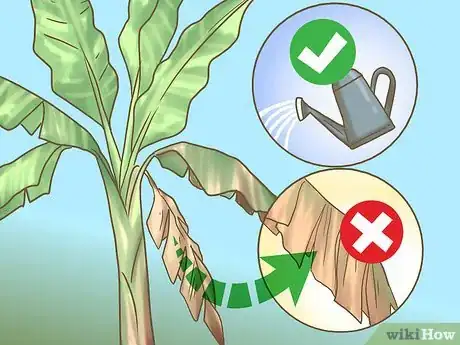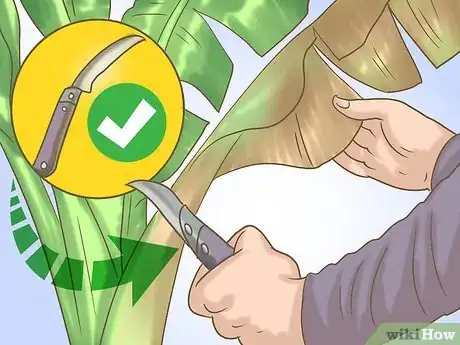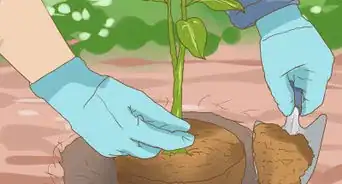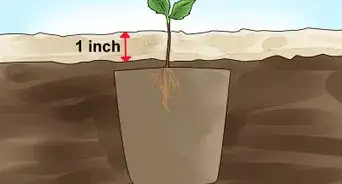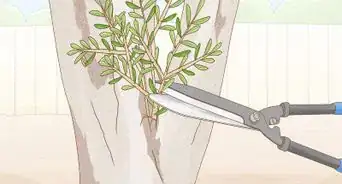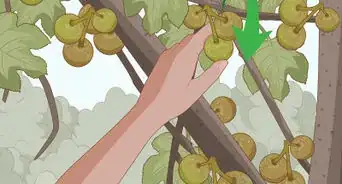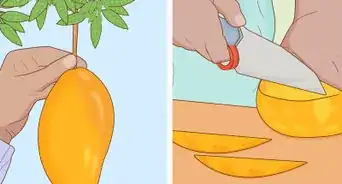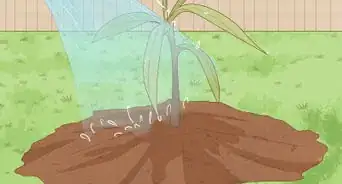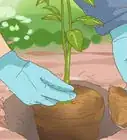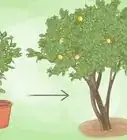This article was co-authored by Grant Wallace. Grant Wallace is a Landscaper and Owner of Grantlanta Lawn in Atlanta, Georgia. With over seven years of experience, he specializes in lawn maintenance and landscape installation. In 2012, he earned his BA from the University of West Georgia. Grant has been profiled in Shoutout Atlanta, Canvas Rebel, and Voyage ATL.
There are 9 references cited in this article, which can be found at the bottom of the page.
This article has been viewed 169,660 times.
Banana trees immediately conjure up a tropical laidback environment. While some of these trees will give you fruit, some people use them just as decoration. Whatever your reasoning for having a banana tree, you will need to maintain the leaves. There are a few easy steps to follow in order to properly prune your banana tree.
Steps
Timing When to Prune Your Banana Tree
-
1Check your banana tree during each season. Paying attention to the time of year will help you to know when to cut the leaves. Banana tree leaves can become damaged for a variety of reasons. Some common reasons include frost, insects and dehydration. These reasons will vary, for instance frost will be after winter while insects tend to be in the spring and dehydration will be during summer.[1]
- Although, there are different reasons for damage, you will approach any dead leaves the same way.
-
2Prune leaves that are brown. Dead or dying banana leaves are quite obvious. They will appear wilted, dry and brown. Once they are brown, there is no reviving them and it will be necessary to prune them in order to keep your banana tree looking lush.[2]
- Be sure to make sure your banana plant is getting enough water. If you live in an area that gets plenty of rainwater, you will not need to give your tree any additional water. If you live in a dry area, be sure to water the tree until the soil is moist.[3]
Advertisement -
3Watch for leaves with holes to know which stems to prune. If your banana tree leaves have holes, they might have been affected by insects. This commonly happens during spring and summer. If this is the case, you might need to treat your tree with medicine or other treatments.[4]
- Although banana trees are not often infected with insects, it’s good to stay aware of any ailment your tree might have.
-
4Inspect for damage after frost. If you have not prepared your plant for winter and instead decided to brave the cold, you will need to see how your banana tree withstood the low temperatures. Although, banana trees are a tropical plant, many people have said their tree managed to withstand cold weather. [5]
- A banana tree damaged by frost will have leaves that first look withered before they eventually turn brown.
- One common way to avoid damage from frost is to actually dig up and move the plant. However, if this is not an easy option, you can cut the stalk down to about one foot off the ground. Then, cover the stalk with a plastic pot, to protect from the elements.[6]
Cutting the Leaves
-
1Trim any brown dead leaves with garden shears. You will easily be able to tell dead palm leaves from their brown color and dry texture. Palm leaves can become damaged from a variety of reasons but the most common is because of weather. Be sure to only cut the leaves and do not yet prune the stems or trunk.[7]
- Start from the outermost layer of leaves and work your way in.
- If you want to prune the stem all the way back to the trunk because of damage, you should note that this will probably affect the flowering capability.
-
2Use a sharp blade or knife to prune the stem. Cut the stalk with a clean and sharp knife about ½ to 1 inch from the trunk. Regular pruning will allow your banana plant to remain looking lush.
- Make sure you have waited until you have harvested any fruit and until your plant has flowered before you prune the stem.[8]
-
3Cut any suckers that have sprouted. If any suckers have sprouted away from your main banana plant, you will need to cut them down as they have a tendency to spread. It is suggested to leave at least one main sucker for your actual banana tree.[9]
- The main stalk is often referred to as the maiden or mother plant. If you have a fruit bearing tree, a stalk will only bear fruit one time.
Expert Q&A
-
QuestionShould you trim the leaves on a banana plant in winter?
 Grant WallaceGrant Wallace is a Landscaper and Owner of Grantlanta Lawn in Atlanta, Georgia. With over seven years of experience, he specializes in lawn maintenance and landscape installation. In 2012, he earned his BA from the University of West Georgia. Grant has been profiled in Shoutout Atlanta, Canvas Rebel, and Voyage ATL.
Grant WallaceGrant Wallace is a Landscaper and Owner of Grantlanta Lawn in Atlanta, Georgia. With over seven years of experience, he specializes in lawn maintenance and landscape installation. In 2012, he earned his BA from the University of West Georgia. Grant has been profiled in Shoutout Atlanta, Canvas Rebel, and Voyage ATL.
Landscaper You can, but you don't have to. Banana trees go dormant in winter; at that time, their leaves get droopy and crispy. In the spring, the banana tree will push out new growth. Some homeowners prefer to cut off the crispy parts to give their tree a cleaner look, but it's subjective.
You can, but you don't have to. Banana trees go dormant in winter; at that time, their leaves get droopy and crispy. In the spring, the banana tree will push out new growth. Some homeowners prefer to cut off the crispy parts to give their tree a cleaner look, but it's subjective. -
QuestionI ordered a banana plant. when it arrived, all of the leaves were dead. The trunk is healthy. I cut all of the leaves off and have nothing but a trunk. Will new leaves grow? I am growing indoors.
 Ethan SmithCommunity AnswerIf you have proper growing conditions and water the right amount (depends on where you're living due to humidity and temperature), then new leaves might grow. However, if you cut off all the leaves and there are none left, you will have to give it plant food and it may not grow any back. The leaves gather food and energy for the plant.
Ethan SmithCommunity AnswerIf you have proper growing conditions and water the right amount (depends on where you're living due to humidity and temperature), then new leaves might grow. However, if you cut off all the leaves and there are none left, you will have to give it plant food and it may not grow any back. The leaves gather food and energy for the plant. -
QuestionA couple of the leaves on my banana tree have dead areas on them but otherwise look healthy. Should I remove just the dead areas and leave the rest of the leaf alone?
 AsukiwaCommunity AnswerYes, remove just the dead areas so the plant can receive more light and fresh air to grow better.
AsukiwaCommunity AnswerYes, remove just the dead areas so the plant can receive more light and fresh air to grow better.
Warnings
- Garden tools like shears and knives are very sharp. Keep them out of the reach of children and pets.⧼thumbs_response⧽
Expert Interview

Thanks for reading our article! If you'd like to learn more about pruning banana trees, check out our in-depth interview with Grant Wallace.
References
- ↑ https://www.rhs.org.uk/advice/profile?pid=311
- ↑ http://www.tropicamango.com/banana.html
- ↑ https://www.starkbros.com/growing-guide/how-to-grow/fruit-trees/banana-plants/watering
- ↑ http://www.fao.org/docrep/006/t0308e/T0308E05.htm
- ↑ https://www.seattletimes.com/life/lifestyle/exotic-banana-plants-survive-winter-if-they-get-shelter-from-the-elements/
- ↑ http://www.walterreeves.com/landscaping/banana-overwintering/
- ↑ https://gardenerdy.com/banana-tree-care
- ↑ https://www.tropicalpermaculture.com/growing-bananas.html
- ↑ http://www.promusa.org/Banana+sucker
About This Article
Having a healthy banana tree means knowing when and how to prune the leaves. Check your banana tree frequently for signs of dehydration and frost or insect damage, which can happen any time of year. When you see brown, dry, wilted leaves, use a pair of garden shears to cut the outermost layer of leaves and work your way in toward the stem. When you get to the stem, use a sharp blade or knife to cut the stalk to about 1 inch from the trunk. Make sure you have harvested any fruit and your plant has already flowered before pruning the stem. To learn how to treat holes in your banana tree’s leaves, keep reading!

